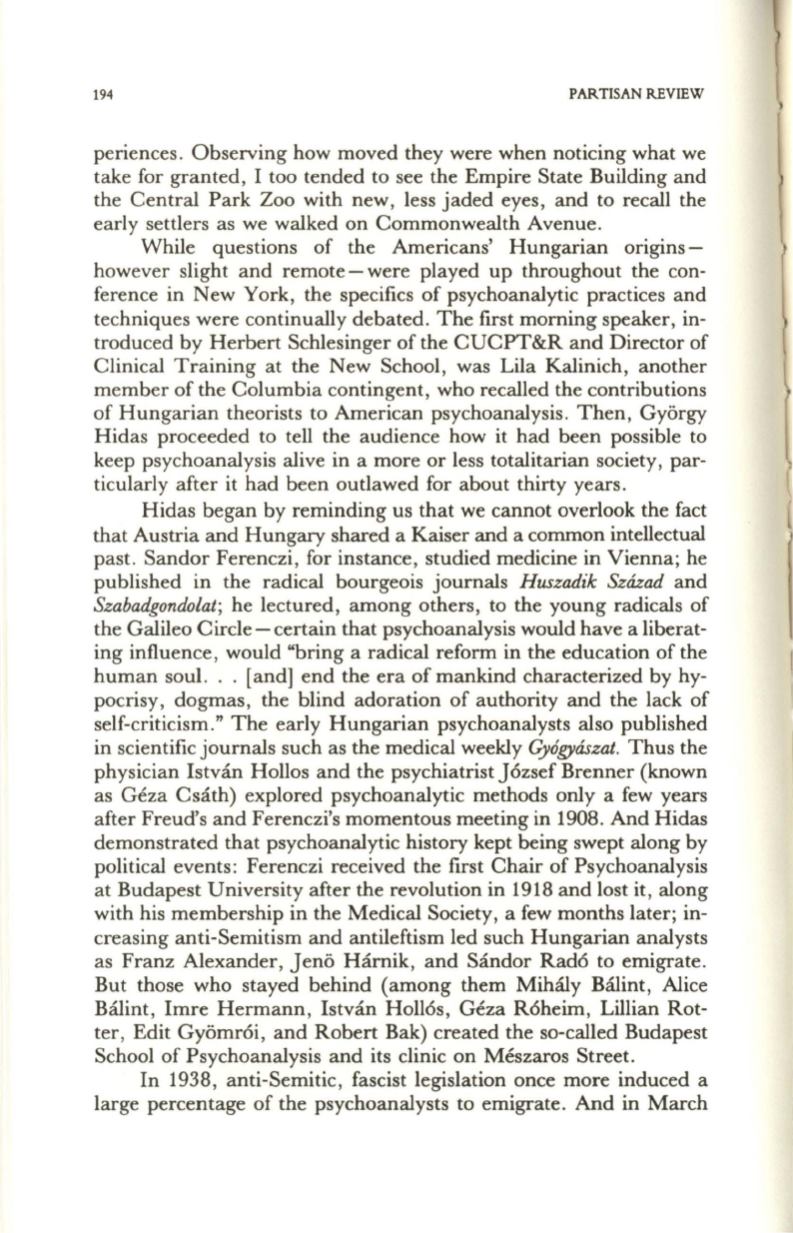
194
PARTISAN REVIEW
periences. Observing how moved they were when noticing what we
take for granted, I too tended to see the Empire State Building and
the Central Park Zoo with new, less jaded eyes, and to recall the
early settlers as we walked on Commonwealth Avenue.
While questions of the Americans' Hungarian origins–
however slight and remote - were played up throughout the con–
ference in New York, the specifics of psychoanalytic practices and
techniques were continually debated. The first morning speaker, in–
troduced by Herbert Schlesinger of the CUCPT&R and Director of
Clinical Training at the New School, was Lila Kalinich, another
member of the Columbia contingent, who recalled the contributions
of Hungarian theorists to American psychoanalysis . Then, Gyargy
Hidas proceeded to tell the audience how it had been possible to
keep psychoanalysis alive in a more or less totalitarian society, par–
ticularly after it had been outlawed for about thirty years .
Hidas began by reminding us that we cannot overlook the fact
that Austria and Hungary shared a Kaiser and a common intellectual
past . Sandor Ferenczi, for instance, studied medicine in Vienna; he
published in the radical bourgeois journals
Huszadik Sztizad
and
Szabadgondolat ;
he lectured , among others, to the young radicals of
the Galileo Circle - certain that psychoanalysis would have a liberat–
ing influence, would "bring a radical reform in the education of the
human soul. . . [and] end the era of mankind characterized by hy–
pocrisy , dogmas , the blind adoration of authority and the lack of
self-criticism." The early Hungarian psychoanalysts also published
in scientific journals such as the medical weekly
Gyogyaszat.
Thus the
physician Istvan Hollos and the psychiatrist J 6zsef Brenner (known
as Geza Csath) explored psychoanalytic methods only a few years
after Freud's and Ferenczi's momentous meeting in 1908. And Hidas
demonstrated that psychoanalytic history kept being swept along by
political events: Ferenczi received the first Chair of Psychoanalysis
at Budapest University after the revolution in 1918 and lost it, along
with his membership in the Medical Society, a few months later; in–
creasing anti-Semitism and antileftism led such Hungarian analysts
as Franz Alexander, Jena Harnik, and Sandor Rad6 to emigrate.
But those who stayed behind (among them Mihaly Balint, Alice
Balint, Imre Hermann, Istvan Ho1l6s, Geza R6heim, Lillian Rot–
ter , Edit Gyamr6i, and Robert Bak) created the so-called Budapest
School of Psychoanalysis and its clinic on Meszaros Street.
In
1938, anti-Semitic , fascist legislation once more induced a
large percentage of the psychoanalysts to emigrate. And in March


